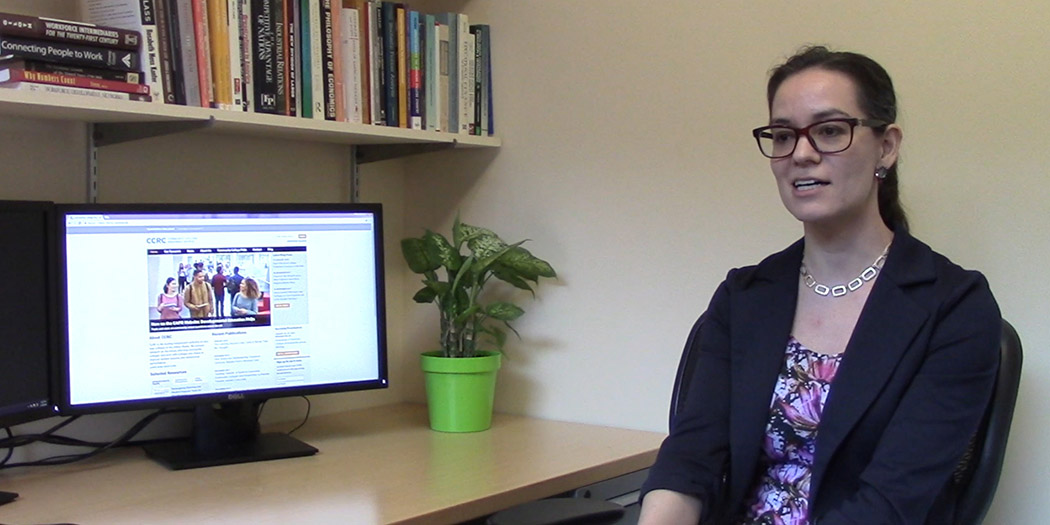We’ve all heard about the ever-increasing amount of student debt, which has reached a total of nearly $1.4 trillion. But Judith Scott-Clayton, a researcher with CCRC and associate professor at Teachers College, dug around in some new data released by the U.S. Department of Education and found widely different impacts from the debt on different students. The new data allow researchers to track students for 12 years after entering college for one group and 20 years for another, giving a much more complete picture of debt and default in the longer term than was possible before.
In an analysis for Brookings, Scott-Clayton found that Black borrowers and students at for-profit colleges are hit harder by defaults than most other groups. Overall, she projects that nearly 40% of borrowers who started in 2003–04 could default by 2023. She discusses her findings in a new video.
Transcript
One thing right away that jumped out at me that we really wouldn’t know without data like this is that defaults continue to rise even after the 12-year point relative to initial college entry. It’s not like things have settled down and if you can get them out to 12 years, then you pretty much know what’s going to happen. There are still a lot of defaults that continue to happen after that point. I think what’s really surprising about it is that you wouldn’t predict that many defaults based on the amounts that students are borrowing. The amounts that students are borrowing, although it is much more than in the past, we all know that, most students are borrowing amounts that are very much manageable compared to their earnings, and certainly compared to the high payoff that we and other researchers have documented consistently—the high payoff to a college degree.
People often ask, is there a crisis in student loans. And I think these data show that yes, there absolutely is. But it’s not the one that people often think we have. The crisis that people are often imagining is that there’s this huge bubble, and there are so many loans outstanding, and none of it is going to get repaid, and students are borrowing way too much, and how can they afford to do anything. That’s not the crisis. The crisis is the number of defaults that we’re seeing among students who are borrowing relatively small amounts, and that’s a crisis for the students. That is not a crisis for the federal taxpayer because those are very small amounts of debt, for the most part.
I think what it also suggests to me is that—and other scholars have pointed this out as well—the huge issues in getting students into repayment plans that work for them. Many people have proposed having an income-contingent repayment system that just runs automatically through the Treasury Department and comes out after somebody starts making a certain amount of money—just comes out as a percentage until they’ve paid back their loans.
I think the other thing that really stands out are the racial disparities and the fact that while in general earning a degree appears highly protective of these bad loan outcomes, so in general earning a degree means a much lower likelihood of default. But I find that even for Black college graduates, a Black college graduate is more likely to experience a default than a White college dropout. So a lot of prior discussions of this topic have rightly focused attention on dropouts because that is where the concentration of the problem is. But I think it’s also important to realize that it’s not like everybody who has a bachelor’s degree is home free, and that there are very stark racial disparities along that dimension, and if you just look at the averages and don’t split things out, you would completely miss that story.
Prior reports have noted that a student who borrows to attend a community college also has a much higher default likelihood than students at four-year institutions. But because so many fewer students at community colleges borrow, when you look as a percentage of the whole entering student cohort, community colleges look just fine. In fact, if you look across the sectors on that metric, only about one in 10 entrants experiences a default at any sector outside of the for-profit sector. Within the for-profit sector it’s more than half of all entrants experiencing a default. So it’s basically the typical experience.
Certificates are one where if you just look at defaults by degree attainment, you’ll find that certificate holders actually have a higher default rate than dropouts, which is definitely striking and a little alarming. When you split it out by sector, you see that that’s really explained by the fact that a lot of certificates are coming from the for-profit sector. Certificates don’t look particularly problematic outside the for-profit sector.
So I think one implication is that now is probably not the time to be weakening and watering down the regulations of the for-profit sector. A second implication is to keep pushing to improve the income-contingent repayment plans, to reduce the paperwork and make it easier for students to get into those plans before they run into trouble. And then finally to start digging further into the racial disparities to try to better understand where those are coming from, what the sources of that are, and to keep up the push to improve completion rates across the board, because we know that that’s a major predictor of who’s able to pay back their loans or not.




